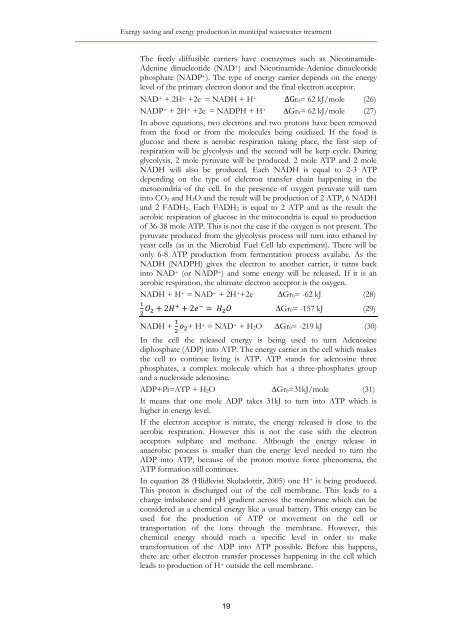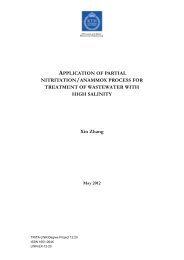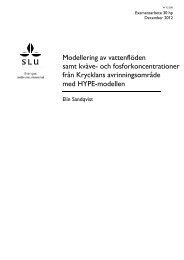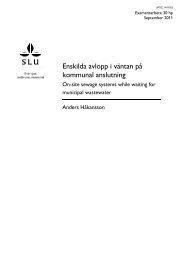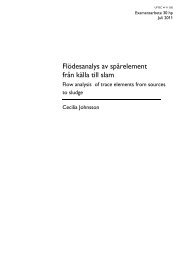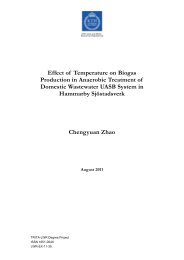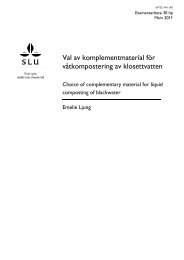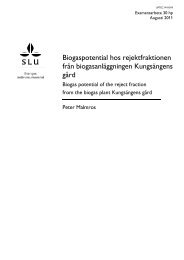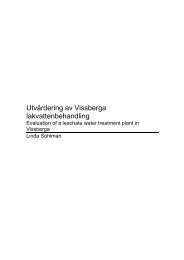Exergy saving and exergy production in municipal wastewater ...
Exergy saving and exergy production in municipal wastewater ...
Exergy saving and exergy production in municipal wastewater ...
You also want an ePaper? Increase the reach of your titles
YUMPU automatically turns print PDFs into web optimized ePapers that Google loves.
<strong>Exergy</strong> <strong>sav<strong>in</strong>g</strong> <strong>and</strong> <strong>exergy</strong> <strong>production</strong> <strong>in</strong> <strong>municipal</strong> <strong>wastewater</strong> treatment<br />
The freely diffusible carriers have coenzymes such as Nicot<strong>in</strong>amide-<br />
Aden<strong>in</strong>e d<strong>in</strong>ucleotide (NAD + ) <strong>and</strong> Nicot<strong>in</strong>amide-Aden<strong>in</strong>e d<strong>in</strong>ucleotide<br />
phosphate (NADP + ). The type of energy carrier depends on the energy<br />
level of the primary electron donor <strong>and</strong> the f<strong>in</strong>al electron acceptor.<br />
NAD + + 2H + +2e - = NADH + H + r 0= 62 kJ/mole (26)<br />
NADP + + 2H + +2e - = NADPH + H + ∆Gr 0= 62 kJ/mole (27)<br />
In above equations, two electrons <strong>and</strong> two protons have been removed<br />
from the food or from the molecules be<strong>in</strong>g oxidized. If the food is<br />
glucose <strong>and</strong> there is aerobic respiration tak<strong>in</strong>g place, the first step of<br />
respiration will be glycolysis <strong>and</strong> the second will be kerp cycle. Dur<strong>in</strong>g<br />
glycolysis, 2 mole pyruvate will be produced. 2 mole ATP <strong>and</strong> 2 mole<br />
NADH will also be produced. Each NADH is equal to 2-3 ATP<br />
depend<strong>in</strong>g on the type of elelctron transfer cha<strong>in</strong> happen<strong>in</strong>g <strong>in</strong> the<br />
metocondria of the cell. In the presence of oxygen pyruvate will turn<br />
<strong>in</strong>to CO 2 <strong>and</strong> H 2O <strong>and</strong> the result will be <strong>production</strong> of 2 ATP, 6 NADH<br />
<strong>and</strong> 2 FADH 2. Each FADH 2 is equal to 2 ATP <strong>and</strong> as the result the<br />
aerobic respiration of glucose <strong>in</strong> the mitocondria is equal to <strong>production</strong><br />
of 36-38 mole ATP. This is not the case if the oxygen is not present. The<br />
pyruvate produced from the glycolysis process will turn <strong>in</strong>to ethanol by<br />
yeast cells (as <strong>in</strong> the Microbial Fuel Cell lab experiment). There will be<br />
only 6-8 ATP <strong>production</strong> from fermentation process availabe. As the<br />
NADH (NADPH) gives the electron to another carrier, it turns back<br />
<strong>in</strong>to NAD + (or NADP + ) <strong>and</strong> some energy will be released. If it is an<br />
aerobic respiration, the ultimate electron acceptor is the oxygen.<br />
NADH + H + = NAD + + 2H + +2e - ∆Gr 0= -62 kJ (28)<br />
∆Gr 0= -157 kJ (29)<br />
NADH + + H + = NAD + + H 2O ∆Gr 0= -219 kJ (30)<br />
In the cell the released energy is be<strong>in</strong>g used to turn Adenos<strong>in</strong>e<br />
diphosphate (ADP) <strong>in</strong>to ATP. The energy carrier <strong>in</strong> the cell which makes<br />
the cell to cont<strong>in</strong>ue liv<strong>in</strong>g is ATP. ATP st<strong>and</strong>s for adenos<strong>in</strong>e three<br />
phosphates, a complex molecule which has a three-phosphates group<br />
<strong>and</strong> a nucleoside adenos<strong>in</strong>e.<br />
ADP+Pi=ATP + H 2O ∆Gr 0=31kJ/mole (31)<br />
It means that one mole ADP takes 31kJ to turn <strong>in</strong>to ATP which is<br />
higher <strong>in</strong> energy level.<br />
If the electron acceptor is nitrate, the energy released is close to the<br />
aerobic respiration. However this is not the case with the electron<br />
acceptors sulphate <strong>and</strong> methane. Although the energy release <strong>in</strong><br />
anaerobic process is smaller than the energy level needed to turn the<br />
ADP <strong>in</strong>to ATP, because of the proton motive force phenomena, the<br />
ATP formation still cont<strong>in</strong>ues.<br />
In equation 28 (Hlidkvist Skuladottir, 2005) one H + is be<strong>in</strong>g produced.<br />
This proton is discharged out of the cell membrane. This leads to a<br />
charge imbalance <strong>and</strong> pH gradient across the membrane which can be<br />
considered as a chemical energy like a usual battery. This energy can be<br />
used for the <strong>production</strong> of ATP or movement on the cell or<br />
transportation of the ions through the membrane. However, this<br />
chemical energy should reach a specific level <strong>in</strong> order to make<br />
transformation of the ADP <strong>in</strong>to ATP possible. Before this happens,<br />
there are other electron transfer processes happen<strong>in</strong>g <strong>in</strong> the cell which<br />
leads to <strong>production</strong> of H + outside the cell membrane.<br />
19


